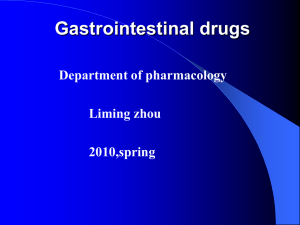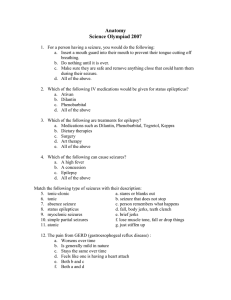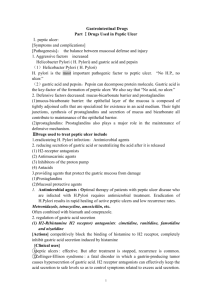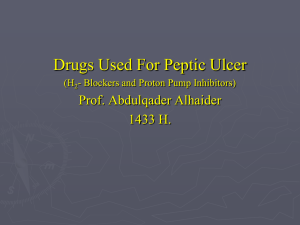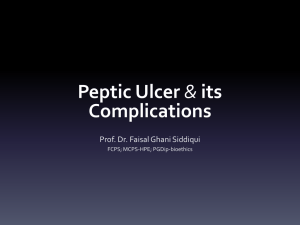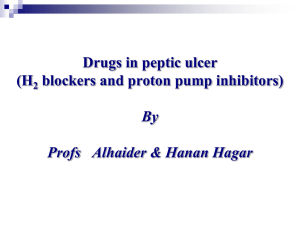Complications of Peptic Ulcer – Dr. Kamal
advertisement
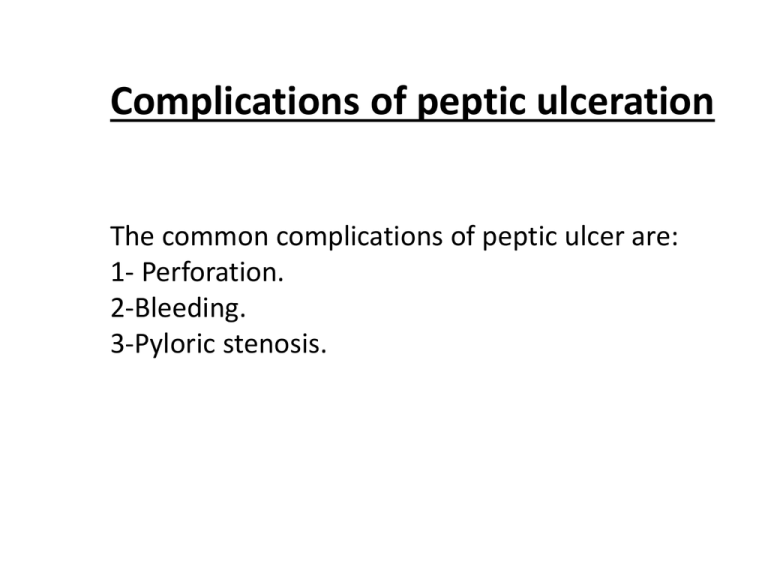
Complications of peptic ulceration The common complications of peptic ulcer are: 1- Perforation. 2-Bleeding. 3-Pyloric stenosis. Perforated peptic ulcer Epidemiology Despite the use of antiulcer agents and eradication therapy, the incidence of perforated peptic ulcer has changed little. Most patients are middle aged, with a ratio more in men than women. Smoking and NSAIDs appear to be responsible for most of these perforations. Clinical features The patient, who may have a history of peptic ulceration, develops sudden-onset, severe, generalized abdominal pain as a result of the irritant effect of gastric acid on the peritoneum. Although the contents of an acid are relatively low in bacterial load, bacterial peritonitis supervenes over a few hours, usually accompanied by a deterioration in the patient’s condition Initially, the patient may be shocked with a tachycardia but a pyrexia is not usually observed until some hours after the event. The abdomen exhibits a board-like rigidity and the patient can not move because of the pain. The abdomen does not move with respiration. Patients with this form of presentation need an operation, without which they will deteriorate with a septic peritonitis. Sometimes perforations will seal as a result of the inflammatory response and adhesion within the abdominal cavity, and so the perforation may be self-limiting. All of these factors may combine to make the diagnosis of perforated peptic ulcer. The most common site of perforation is the anterior aspect of the duodenum. However, the anterior or incisural gastric ulcer may perforate and, in addition, gastric ulcers may perforate into the lesser sac, which can be particularly difficult to diagnose. These patients may not have obvious peritonitis. Investigations An erect plain chest radiograph will reveal free gas under the diaphragm in most of the cases. But CT imaging is more accurate . All patients should have serum amylase levels tested, as distinguishing between peptic ulcer perforation and pancreatitis can be difficult. Measuring the serum amylase, however, may not remove the diagnostic difficulty; it can be elevate following perforation of a peptic ulcer although, fortunately, the levels are not usually as high as the levels commonly seen in acute pancreatitis. Several other investigations are useful if doubt remains. A CT scan will normally be diagnostic in both conditions. Plain abdominal radiograph of a perforated ulcer, showing air under the diaphragm Treatment 1.The patient should be admitted to the hospital 2. Resuscitation ,an IV line and intravenous fluid. 3.Naso gastric tube put. 3.Analgesia should not be with held for fear of removing the signs of an intraabdominal problem. 4.Following resuscitation, the treatment is principally surgical. Laparotomy is performed, usually through an upper midline or right upper paramedian incision if the diagnosis of perforated peptic ulcer can be made with confidence. This is not always possible and, hence, it may be better to place a small incision around the umbilicus to localize the perforation with more certainty. Alternatively, laparoscopy may be used. The most important component of the operation is a thorough peritoneal toilet to remove all of the fluid and food debris. If the perforation is in the duodenum it can usually be closed by several well-placed sutures. It is common to place an omental patch over the perforation in the hope of enhancing the chances of the leak sealing. Gastric ulcers should, if possible, be excised and closed, and sent for histopathology so that malignancy can be excluded. Occasionally, a patient is seen who has a massive duodenal or gastric perforation such that simple closure is impossible; in these patients, partial gastrectomy is a useful operation. All patients should be treated with systemic antibiotics. The stomach should be kept empty postoperatively by nasogastric and gastric anti-secretory agents are commenced to promote healing in the residual ulcer. HAEMATEMESIS AND MELAENA Upper gastrointestinal hemorrhage remains a major medical problem. Despite improvements in diagnosis and the proliferation in treatment modalities An in hospital mortality still can be expected. Causes of upper gastrointestinal bleeding 1.Ulcers : Oesophageal ,Gastric and Duodenal 2.Erosions: Oesophageal ,Gastric and Duodenal 3.Mallory–Weiss tear (syndrome) 4.Oesophageal varices 5.Tumour (mainly gastric) 6.Vascular lesions, e.g. Dieulafoy’s disease Whatever the cause, the principles of management are identical. The patient should be first resuscitated and then investigated urgently to determine the cause of the bleeding. Only then should definitive treatment be instituted. For any significant gastrointestinal bleed, 1-Intravenous access should be established and Blood should be cross-matched and the patient transfused as clinically indicated 2-For severe bleeding, central venous pressure monitoring should be set up 3-Bladder catheterization performed. As a general rule, most gastrointestinal bleeding will stop, but there are some cases when this is not. In these circumstances, resuscitation, diagnosis and treatment should be carried out in quick succession. There are occasions when life-saving manoeuvres have to be undertaken without the benefit of an absolute diagnosis. For instance, in patients with known oesophageal varices and uncontrollable bleeding, a Sengstaken–Blakemore tube may be inserted before an endoscopy has been carried out. The most important current causes of this are liver disease. In this circumstance, the coagulopathy should be corrected, if possible, with freshfrozen plasma. Upper gastrointestinal endoscopy should be carried out by an experienced operator as soon as practicable after the patient has been stabilised. In patients in whom the bleeding is relatively mild, endoscopy may be carried out on the morning after admission. In all cases of severe bleeding it should be carried out immediately GASTRIC OUTLET OBSTRUCTION The two common causes of gastric outlet obstruction are: 1-pyloric stenosis secondary to peptic ulceration. 2- gastric cancer(prepyloric tumor). Clinical features *There is usually a long history of peptic ulcer disease. *pain: the pain may become unremitting but in other cases it may largely disappear. *Vomiting: The vomitus is totally lacking in bile(nonbilious). Very often it is possible to recognise foods taken several days previously. *The patient commonly loses weight, and appears unwell and dehydrated. On examination it may be possible to see the distended stomach and a succussion splash may be audible on shaking the patient’s abdomen. Metabolic effects The vomiting of hydrochloric acid results in hypochloraemic alkalosis but, initially, sodium and potassium levels may be relatively normal. However, as dehydration progresses, more profound metabolic abnormalities arise. Initially, the urine has a low chloride and high bicarbonate content, reflecting the primary metabolic abnormality. This bicarbonate is excreted along with sodium and so, the patient becomes progressively hyponatraemic and more dehydrated,a phase of sodium retention follows and potassium and hydrogen are excreted in preference. This results in the urine becoming paradoxically acidic and hypokalaemia .Alkalosis leads to a lowering of the circulating ionised calcium, and tetany can occur Management 1-The patient should be rehydrated with intravenous isotonic saline with potassium supplementation. 2-If the patient is anaemic it should be corrected. 3-The stomach should be emptied using a wide-bore gastric tube. 4-This then allows investigation of the patient with endoscopy and contrast radiology. Biopsy of the area around the pylorus is essential to exclude malignancy. 5-The patient should also have an anti-secretory agent. 6- severe cases are treated surgically, usually with a gastroenterostomy. Endoscopic treatment with balloon dilatation has been practised and may be most useful in early cases. However, this treatment is not devoid of problems. Dilating the duodenal stenosis may result in perforation, and the dilatation may have to be performed several times and may not be successful in the long term.

